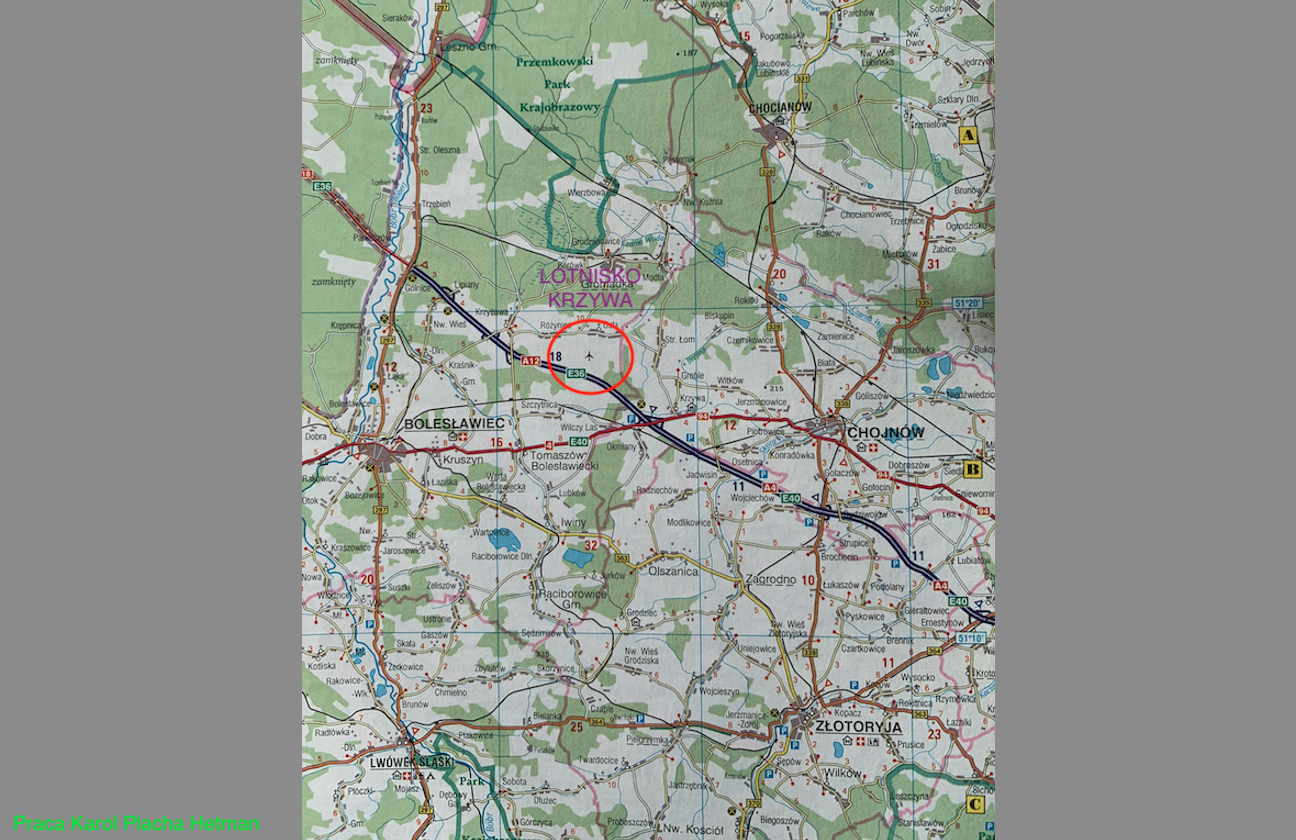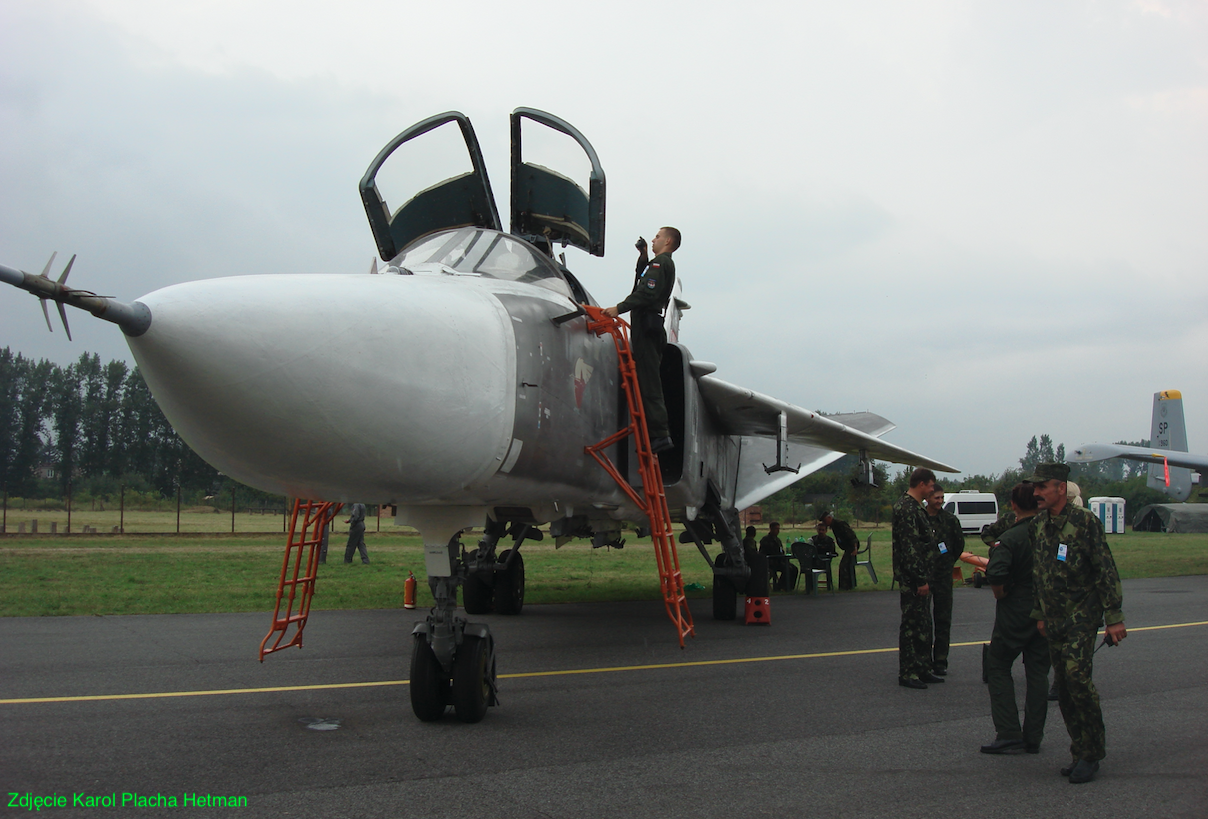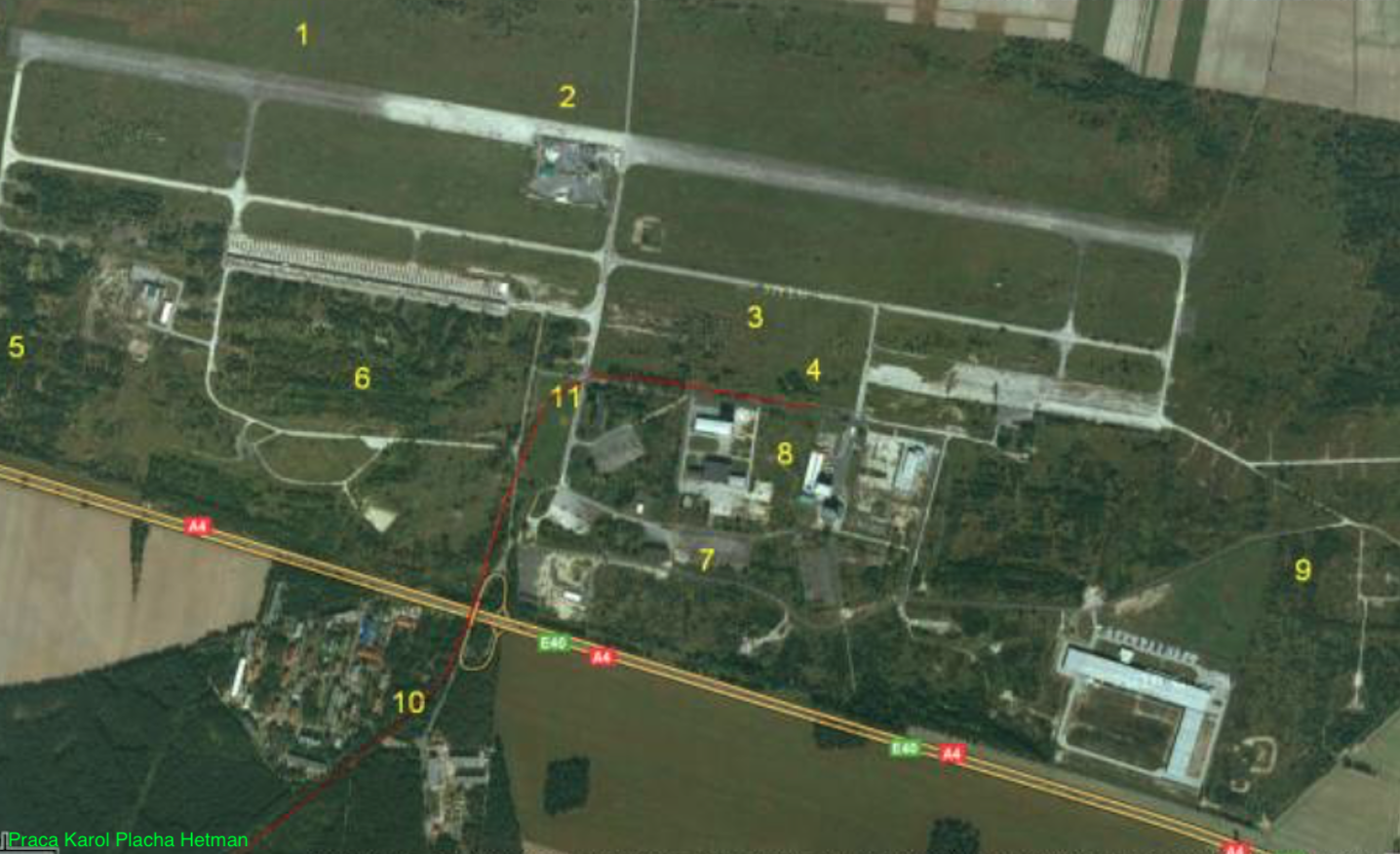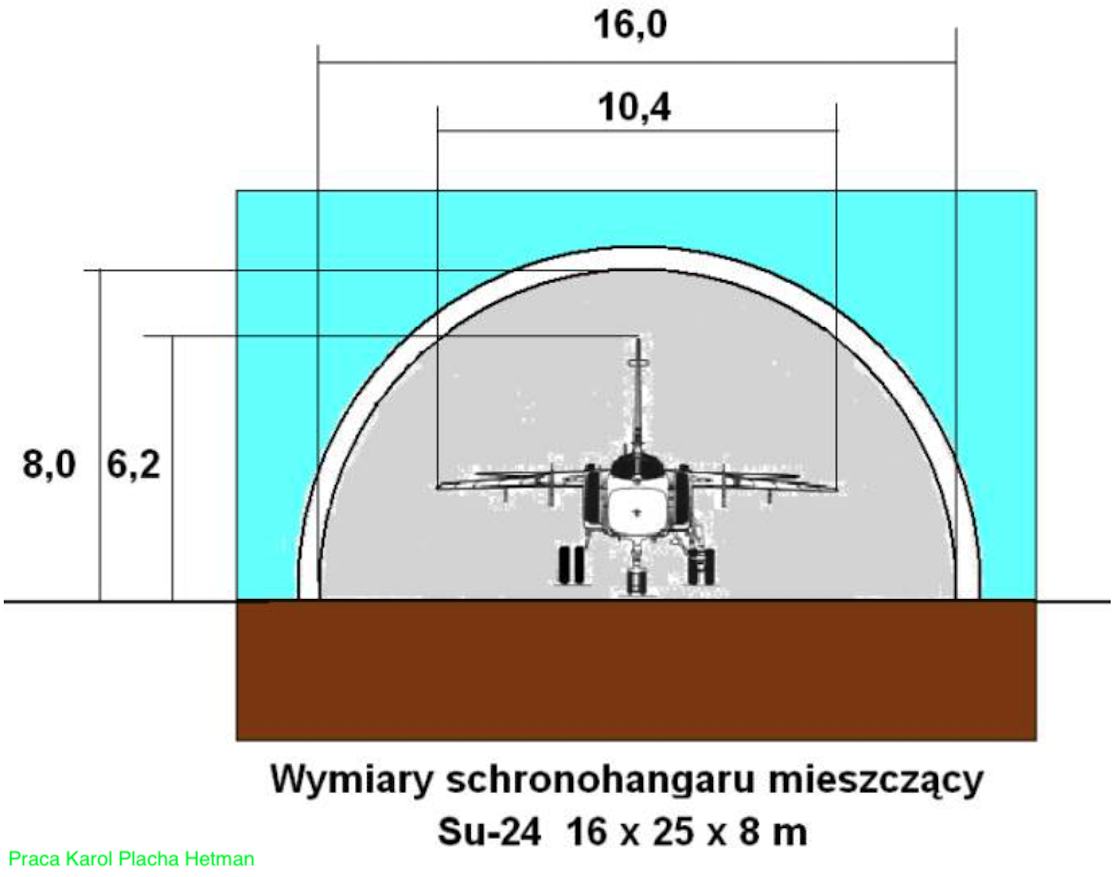Legnica 2011-09-28
Byłe sowieckie lotnisko w Krzywej koło Legnicy.
Współrzędne geograficzne: 51.311 N 15.729 E. Elewacja 207 m.
Lotnisko Krzywa.
Lotnisko Krzywa przeszło już do historii i żaden samolot z niego już nie wystartuje. Lotnisko Krzywa to kolejne lotnisko na terenie Polski eksploatowane przez blisko 50 lat przez wojska państwa moskiewskiego. Było to jedno z najważniejszych sowieckich lotnisk na terenie Polski, obok lotnisk w Brzegu, Chojnie, Bagiczu, Kluczewie, Szprotawie i innych. Lotnisko w Krzywej leżało w Województwie Dolnośląskim w pobliżu miejscowości Bolesławiec, pomiędzy miejscowościami Różniec i Szczytnica, przy autostradzie A 4. Obiekt eksploatowany przez sowietów położony jest na granicy Gminy Warta Bolesłwiecka i Gminy Gromadka. Na terenie Gminy Warta Bolesławiecka znajduje się osiedle mieszkalne. Zostało ono przypisane do miejscowości Szczytnica. Na terenie Gminy Gromadka znajduje się Lotnisko. Wszystko dlatego, że granicą jest autostrada A 4.
Historia Lotniska Krzywa.
Bardzo trudno jest ustalić, w którym roku Lotnisko Krzywa powstało. Przypuszczalnie zaczęto jego budowę w momencie, kiedy autostrada z Drezna do Wrocławia była już praktycznie ukończona. Lokalizacja lotniska została zdeterminowana właśnie przebiegiem autostrady. Bocznicę kolejową na lotnisko doprowadzono już w trakcie drugiej wojny światowej. We wrześniu 1939 roku, z Lotniska Krzywa startowały germańskie bombowce do ataku na Polskie miasta.
O lotnisku Krzywa należy napisać, że w dniu 1 października 1938 roku, germańskie wojska lotnicze, kupiły ziemię na założenie lotniska. Lotnisko weszło w skład legnickiego węzła lotnisk. Oprócz samego lotniska zbudowano warsztaty, które służyły do montażu i remontu samolotów bojowych. Po wybuchu wojny, w lasach koło miejscowości Szczytnica, germańcy założyli obóz jeniecki. Jeńcy pracowali nie tylko przy rozbudowie lotniska, ale także przy montażu samolotów bojowych. Były to między innymi myśliwce Focke-Wulf Fw 190. Dzisiaj nie wiadomo w którym miejscu był dokładnie obóz jeniecki. Wiadomo, że jeńcy idąc na lotnisko musieli przechodzić tunelem pod autostradą Wrocław-Drezno/Berlin. Na zdjęciach satelitarnych lasów na południe od autostrady, widać miejsca porośnięte innymi drzewami.
W dniu 15 lutego 1945 roku, Lotnisko Krzywa zostało zajęte przez wojska sowieckie. Teoretycznie Lotnisko zostało przyznane Wojsku Polskiemu. Ale to tylko teoria i nigdy nie stacjonowały tu Polskie samoloty. Według dostępnych informacji, w 1953 roku, obiekt oficjalnie przejęli żołnierze sowieccy. Przypuszczalnie był to efekt porozumienia PGW AR z dowództwem Wojska Polskiego, co i tak było wówczas fikcją, bo najwyżsi dowódcy w Wojsku Polskim to byli obywatele państwa moskiewskiego. Na podstawie tego porozumienia między innymi Polsce przyznano Lotnisko Malbork i Lotnisko Siemirowice, a oddano Lotnisko Krzywa.
Lotnisko Krzywa miało doskonałe położenie dla sowieckiego lotnictwa bojowego. Było blisko dużych kompleksów poligonowych i w pobliżu granic państwowych oraz w niewielkiej odległości jest Miasto Legnica, z dowództwem PGW AR.
Od 1953 roku, moskale przystąpili do rozbudowy Lotniska Krzywa. Było to konieczne, gdyż opracowywane wówczas samoloty wymagały coraz dłuższych RWY. Bardzo rozbudowano zaplecze lotniska. Zbudowano kolejne hangary. Lotnisko Krzywa stało się silną bazą sowiecką na terenie Polski.
Obszar Lotniska kształtem zbliżony jest do prostokąta. Około 3 400 m długości i 1 400 m szerokości. Całkowita powierzchnia, razem z osiedlem mieszkaniowym to 476 hektarów. Infrastruktura była bardzo bogata, o czym napisaliśmy poniżej.
Nazwa Lotniska Krzywa.
Dlaczego Lotnisko zostało nazwane Krzywa? Miejscowość Krzywa leży w odległości około 8 km, na wschód od lotniska. Jednak bliżej są takie Miejscowości jak Różyniec, Osła, a nawet Szczytnica. Sedno sprawy było jednak w drodze prowadzącej z Legnicy na Lotnisko. Sowieccy żołnierze jadąc z Legnicy jechali drogą, która obecnie ma Nr 94, przez Chojnów, a ostatnią miejscowością przed Lotniskiem była właśnie miejscowość Krzywa. Dlatego Lotnisko tak nazwano. W literaturze możemy spotkać także informację, że Legnica dysponowała dwoma lotniskami. Właśnie Lotnisko Krzywa było tym drugim lotniskiem.
Jednostki sowieckie w Krzywej.
Do 1992 roku, stacjonował tu 3. Pułk Lotnictwa Bombowego. Podlegał on Kluczowi Dowodzenia 149. Dywizji Lotnictwa Bombowego, z Lotniska Szprotawa. 3. Pułk Lotnictwa Myśliwskiego, razem z całą Dywizją do Polski został przebazowany w dniu 1.05.1955 roku, z Chin. Co ciekawe samoloty pozostały w Chinach. Tylko personel przetransportowano koleją. Cała kadra Dywizji trafiła na Lotnisko Szprotawa. 3. PLM na początek wyposażono w samoloty myśliwskie MiG-17 i szkolno-treningowe UTMiG-15 (MiG-15 UTI). W dniu 1.09.1960 roku, pułk stał się jednostką myśliwsko-bombową (3. PLM-B) i zaczęto przezbrajać w samoloty myśliwsko-bombowe Su-7 B. Były to samoloty zdolne do przenoszenia bomb jądrowych (atomowych, jak wówczas mówiono). Z całą pewnością, w 1960 roku, na Lotnisku Krzywa zaczęto budować bombo-skład dla bomb jądrowych (atomowych). W 1961 roku, 3. PLM-B został przebazowany na Lotnisko Krzywa. Pułk dysponował wówczas samolotami Su-7 B, Su-7 BM, Su-7 U. Samoloty te eksploatowano do 1976 roku, kiedy to rozpoczęto pułk przezbrajać w samoloty MiG-27. Jako szkolno-bojowe używano MiG-23 UB. Samoloty MiG-27 eksploatowano tylko do 1982 roku.
Zagrożenie dla komunizmu, spowodowane powstaniem w Polsce Solidarności, przyspieszyło przezbrajanie pułku w samoloty bojowe Su-24, o znacznie większych możliwościach. Od dnia 1.12.1988 roku, 3. PLM-B stał się 3. Pułku Lotnictwa Bombowego. Pułk miał na stanie trzy eskadry. Wszystkie uzbrojone w bombowo i bombowo-rozpoznawcze samoloty Su-24. Na przełomie 1990/1991 roku, eskadra Nr 3 została wycofana na teren CCCP. Resztę pułku wycofano do CCCP/Rosji w marcu 1992 roku. W dwóch eskadrach pułk miał wówczas po 10 samolotów Su-24.
Na Lotnisku Krzywa stacjonował także 164. Kerczeński Samodzielny Pułk Lotnictwa Rozpoznawczego Gwardii. Było to w okresie od dnia 30.11.1952 roku do dnia 31.12.1958 roku. Ten sam pułk powrócił na Lotnisko Krzywa w dniu 1.11.1990 roku, i stacjonował do opuszczenia Lotniska Krzywa przez samoloty bojowe, czyli do dnia 14.05.1992 roku. Pułk miał wówczas na wyposażeniu samoloty typu myśliwskie MiG-25.
Broń jądrowa (atomowa) na terenie Lotniska Krzywa.
Na 99% możemy napisać, że na terenie Lotniska Krzywa sowieci posiadali ładunki jądrowe. Do dnia dzisiejszego moskale nic na ten temat nie mówią. Liczba zgromadzonych ładunków i ich moc, jak dotąd nie zostały ujawnione. Wiemy, że na terenie Polski w trzech składach (Templewo, Podborsk, Brzeźnica) zgromadzono 178 ładunków przeznaczonych dla Polskich jednostek wojskowych. Analitycy ocieniają, że sowieci dla swoich wojsk mieli około 300 ładunków. Według nas jest to liczba stanowczo zaniżona. Wiemy, iż w październiku 1990 roku, na terenie Polski stacjonowało aż 81 samolotów Su-24. Głównie w Szprotawie i Krzywej. Na samym Lotnisku Krzywa stacjonowały 30-36 samoloty Su-24. Samolot Su-24 został specjalnie opracowany do przełamywania obrony przeciwnika, na małej wysokości (do 200 m nad ziemią) z prędkością 1400 km/h i ataku jądrowego na wybrane cele. Na jeden samolot przypadały dwa ładunki jądrowe. Su-24 nie był jedynym ich nosicielem. Uzbrojone w broń jądrową mogły być Su-17, Su-27, MiG-27. Wszystkie one stacjonowały w Polsce, w 80-latach XX wieku. Do tego doliczmy ładunki jądrowe dla sowieckich wojsk rakietowych.
Oficjalnie władze PRL i Kreml zaprzeczały składowaniu broni jądrowej na terenie Polski. Pierwsi sekretarze PZPR bez mrugnięcia okiem gładko mówili o Polsce „wolnej od tej śmiercionośnej, strasznej broni”. A w Polskiej TV często emitowano filmy dokumentalne i fabularne, o krzywdzie, jaką Amerykanie wyrządzili Japończykom atakami jądrowymi.
Broń jądrowa z terenu Polski została wycofana jeszcze przed rozpoczęciem procesu wycofywania się armii sowieckiej. Zdecydowała o tym obawa przejęcia tej broni przez Polskę lub inne kraje. Kreml obawiał się takiej sytuacji. Na początku opróżniono magazyny z ładunków przeznaczonych dla Wojska Polskiego. Potem był Bagicz, Szprotawa, Chojna i inne.
Jednak myliłby się czytelnik, gdyby szukał bombo-składu na terenie samego Lotniska Krzywa. Tam obiektów lub ruin obiektów się nie znajdzie. Bombo-skład dla Lotniska Krzywa został zorganizowany w odległości około 3 km od osiedla Krzywa, w kierunku południowo-zachodnim, w samym środku lasu. Dojazd zapewnia droga łącząca miejscowości Krzyżową z Tomaszowem Bolesławskim. Obiekt zajmował powierzchnię 9 hektarów. Był kwadratem o bokach o długości 300 m. Na około wiodła droga, po której poruszali się wyłącznie wartownicy, pieszo lub samochodami. Na terenie było około 15 różnych budowli. Cały teren był zamaskowany i praktycznie nie do rozpoznania z powietrza.
Należy także pamiętać, iż w odległości około 10 km od Lotniska Krzywa w Borach Dolnośląskich znajdowały się kolejne dwa sowieckie składy broni. Każdy z nich zajmował powierzchnie około 50 hektarów.
Sowieci do domu. 1992 rok.
W okresie 1991-1992, Lotnisko Krzywa stało się ważnym punktem, przez który moskale wycofywali się do państwa moskiewskiego. Codziennie maszyny transportowe odlatywały do Moskwy i przylatywały z powrotem. Ostatecznie w dniu 21.08.1992 roku, Lotnisko przekazano Wojsku Polskiemu.
Infrastruktura Lotniska Krzywa.
Współrzędne Lotniska; 51°18’28″N 15°43’40″E ( 51.311N, 15.729E ). Elewacja RWY 207 m. Obszar Lotniska kształtem zbliżony jest do prostokąta. Około 3 400 m długości i 1 400 m szerokości. Całkowita powierzchnia, razem z Osiedlem mieszkaniowym to 476 hektarów.
Opis zdjęcia: Lotnisko Krzywa. 1 RWY. 2 Betoniarnia. 3 Pole wzlotów. 4 Wieża kontroli lotów. 5 Zachodnia strefa rozśrodkowania samolotów bojowych. 6 Centralna strefa rozśrodkowania samolotów bojowych. 7 Strefa hangarów. 8 Strefa zakładów produkcyjnych i firm. 9 Wschodnia strefa rozśrodkowania samolotów bojowych. 10 Osiedle mieszkaniowe. 11 Budynek koszarowo-sztabowy.
Obecnie (2010 rok) dojazd do Lotniska Krzywa zapewniają dwie drogi. Pierwsza bardziej znana; zjazdem z autostrady A 4, który także doprowadza do Osiedla Mieszkaniowego. Druga możliwość to dojazd lokalną drogą od miejscowości Różyniec lub Osła. Dalej drogą z płyt betonowych prowadzącą na Lotnisko od strony północnej.
Lotnisko Krzywa dysponowało jedną drogą startową RWY, o wymiarach 2 450 m x 60 m, na kierunku 10/28. Powierzchnia to 147 000 m2. Nawierzchnia betonowa. Podczas remontu w 60-latach XX wieku, RWY otrzymała ostateczne wymiary, a przede wszystkim zwiększono jej wytrzymałość (nośność), by mogła przyjmować najcięższe samoloty transportowe. Włącznie z transportowymi An-22. Pamiętajmy, że w pobliżu jest Legnica z całym dowództwem i sztabem PGW AR, ale legnicka droga startowa RWY ma wymiary 1 600 m x 40 m i nie przyjmowała największych samolotów transportowych.
Drogi kołowania. Lotnisko Krzywa dysponowało dużą siecią dróg kołowania. Główna DK została ulokowana równolegle do RWY, po jej południowej stronie. Co ciekawe przy głównej DK nie zostały ulokowane PPS (Płaszczyzny Postoju Samolotów). Łączna długość DK wynosiła około 5 000 m. Średnia szerokość to 20 m. Łączna powierzchnia to ponad 100 000 m kwadratowych.
Płaszczyzny Postoju Samolotów. Na Lotnisku Krzywa zostały zlokalizowane dwie ogromne PPS. Zachodnia o wymiarach 550 m x 70 m i powierzchni 38 500 m kwadratowych. Wschodnia o wymiarach 600 m x 70 m i powierzchni 42 000 m kwadratowych. Według dostępnej wiedzy, te dwie PPS musiały w planach stanowić drugą drogę startową RWY. Jest to jak najbardziej prawdopodobne. Wówczas Lotnisko Krzywa miałoby układ podobny do układu istniejącego na Lotnisku Powidz (z dwiema drogami startowymi). Czy tak było naprawdę, tego pewnie się nie dowiemy. Przy DK zjazdowych z DS, ulokowano jeszcze dwie małe PPS o wymiarach 50 m x 30 m i powierzchni 1 500 m kwadratowych każda. Do tego musimy doliczyć płaszczyzny ulokowane przed hangarami.
Hangary. Dzisiaj trudno określić ile hangarów znajdowało się na Lotnisku Krzywa. Przypuszczalnie było to 6 hangarów. Dwa z nich, będące w najlepszym stanie technicznym, nadające się do remontu i adaptacji zostały przejęte przez firmy; Młynpol i Atlas. Pozostałe były w tak złym stanie technicznym, że groziły zawaleniem. Zarządca Lotniska rozebrał je, zyskując z nich złom i gruz budowlany. Po tych hangarach pozostały tylko puste betonowe place.
Schrono-hangary. Schrono-hangary przeznaczone dla samolotów bojowych były rozmieszczone w trzech strefach rozśrodkowania; zachodniej, centralnej i wschodniej. W zachodniej ulokowano 12 schrono-hangarów. W centralnej 10. We wschodniej 18. Te we wschodniej części zostały rozebrane. Daje to razem 40 schrono-hangarów dla samolotów. Schronohangary na Lotnisku Krzywa mają oznaczenie AU-14 (Angar Ubnia). Bez problemu mieszczą samoloty typu Su-24, za złożonymi skrzydłami. Tego typu schrono-hangar mieści także samolot typu MiG-25 i pokrewne. Natomiast samoloty typu Su-27 i pokrewne wymagały większych schrono-hangarów, oznaczonych AU-16 (Angar Ubnia), których w Krzywej nie było.
Wieża kontroli lotów, została ulokowano niemal w środku bazy. W pewnym momencie przestała odpowiadać potrzebom. Dlatego podobnie, jak na Lotnisku Brzeg, przystąpiono do budowy drugiej wieży kontroli lotów. Zbudowana została w miejscu gdzie obecnie znajduje się betoniarnia.
Na obrzeżach pola wzlotów umieszczono liczne bunkry, punkty stanowisk radiolokacyjnych i obrony przeciwlotniczej. Jeden z bunkrów pełnił rolę SD (Stanowiska Dowodzenia). Na terenie lotniska zlokalizowany był MPS. Posiadał on pojemność całkowitą zbiorników 14 100 m sześciennych. Główny budynek sztabowo-koszarowy umieszczono w odległości 400 m od głównej bramy wjazdowej do bazy. Składa się on z dwóch osobnych budynków połączonych łącznikiem. Budynki są trzy kondygnacyjne (jedna podziemna). Łącznik łączy budynki na trzeciej kondygnacji i podtrzymują go filary. W obiekcie była sala gimnastyczna, łaźnia i aula. Budynek zajmuje powierzchnię około 2 000 m kwadratowych.
Na terenie bazy było także kasyno. Obecnie są tylko ruiny. W centralnej części Lotniska umieszczono plac apelowy, a przy nim charakterystyczny pomnik. Z pomnika na dzień dzisiejszy pozostały ruiny. Cały teren Lotniska był ogrodzony. Ogrodzenie składało się z betonowych słupków i kolczastych drutów, rozciągniętych między nimi. To typowe ogrodzenie obiektów wojskowych w 50-latach. W niektórych miejscach ogrodzenie jest zbudowano z płyt betonowych. Przy głównym wjeździe umieszczono mało imponujące biuro przepustek. W pobliżu głównej drogi samochodowej na Lotnisku umieszczono murowane tablice ozdobione mozaikami. Niektóre z nich przedstawiały flagi poszczególnych republik związku sowieckiego oraz flagi rodzajów sił zbrojnych.
Główne zaopatrzenie Lotniska dokonywano transportem kołowym. Ale lotnisko dysponowało także bocznicą kolejową. Jej długość wynosiła około 3 000 m. Była odnogą linii kolejowej Chojnów-Bolesławiec i dochodziła na teren bazy od strony południowej. Tory kolejowe przecinające główne skrzyżowanie drogowe na Lotnisku.
Lotnisko Krzywa w wolnej Rzeczypospolitej Polskiej.
Lotnisko Krzywa w Polskie ręce zostało przekazane jesienią 1993 roku. W planach MON miało zostać zajęte przez Polskie Lotnictwo Wojskowe, ale do tego nie doszło. Próbowano reaktywować Lotnisko jako cywilne. Zawiązano nawet spółkę Krzywa S.A. Planowano zbudować terminal cargo i obsługiwać ruch towarowy. Z planów tych także nic nie wyszło. Właścicielem gruntu została Gmina Gromadka. W 1997 roku, teren przekazano Legnickiej Specjalnej Strefie Ekonomicznej. W efekcie lotnicze plany zagospodarowania Lotniska nie zostały zrealizowane. Teren rozparcelowano i przeznaczono pod inwestycje przemysłowe.
Osiedle mieszkalne Krzywa.
Osiedle mieszkaniowe rozpoczęto budować w okresie germańskim. Początkowo powstało około 16 bloków, dwupiętrowych, podpiwniczonych, z zagospodarowanym poddaszem. W 60-latach XX wieku, na osiedlu zbudowano także bloki określane jako typ Bolesławiec. Bloki te to jeszcze nie „wielka płyta”, ale wiele elementów było wykonanych już z prefabrykatów. Ostatnimi zbudowanymi blokami były bloki typu Leningrad. Są to pięciopiętrowe budynki, podpiwniczone. Typowa wielka płyta. Trzy lub pięcio-klatkowe. Bez wind. Stolarka drewniana. Okna ograniczone do jednego wzoru. Większość z nich powstała z początkiem 80-latach XX wieku. Wszystkie elementy budynków przywożono transportem kolejowym z fabryk na terenie CCCP. Bloki typu Leningrad na terenie Rzeczypospolitej możemy spotkać w co najmniej 11 byłych sowieckich bazach.
Po wyprowadzce moskali bloki były w bardzo złym stanie. Pozbawione wszystkiego. Pozostały dosłownie tylko ściany. Obecnie powoli, lecz systematycznie bloki są remontowane. Dużo mieszkań znalazło już nowych właścicieli. Administracyjnie osiedle znalazło się pod władzą Gminy Warta Bolesławiecka. Czasami nazywa się je osiedlem miejscowości Szczytnica. A więc nazwa Osiedle Krzywa, przeszło do historii.
Opracował Karol Placha Hetman






